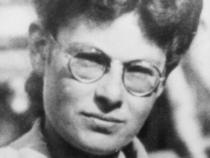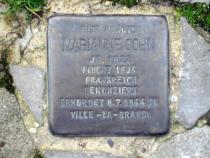Location
Wulfila Ufer 52
District
Tempelhof
Stone was laid
December 2007
Born
17 September 1922 in Mannheim
Escape
Flucht nach Frankreich
Murdered
08 July 1944 in Ville-la-Grande
Marianne Cohn, born on 17 September 1922, lived with her parents, Alfred and Grete Cohn, and her younger sister Lisa at Wulfila Ufer 52 in Berlin-Tempelhof from 1929. After four years’ primary education, she attended the girls’ grammar school at Ring Strasse 103-106, Tempelhof (now the Dag Hammerskjöld Upper School).
Following a brief spell working for Borsig-Hall GmbH, Marianne’s father Alfred became an executive for the engineering works and iron foundry C. Henry Hall, Nachfolger Carl Eichler, where he soon rose to become co-owner. Alfred Cohn was a native Berliner and a friend of Walter Benjamin, whom he had met at grammar school. Their friendship lasted a lifetime and produced much correspondence, which has survived to document events in the lives of the Cohn family members after the Nazis came to power. It was shortly after this historic turning point that Alfred Cohn’s business partner was taken to Oranienburg concentration camp and he himself was advised to leave Germany.
The family immigrated via Paris to Barcelona. Marianne Cohn was issued with a school-leaving certificate on 28 March 1933 succinctly stating that she was leaving “due to the family’s relocation abroad”. In Barcelona, Marianne and her sister Lisa attended a Swiss school. Alfred Cohn tried to support the family by selling fashion jewellery. In addition, the family rented out two rooms of their four-room apartment.
When the Spanish Civil War broke out in 1936, Marianne Cohn’s life changed again. Her parents placed her and her sister in the care of relatives in Paris, where they also went to school. After a year in Paris, Marianne and her sister moved on to Bern, Switzerland. Here they lived with foster families. Marianne Cohn was now 15 years old. The girls’ residence permits for Switzerland expired in April 1938 and were not extended. They returned to Paris to join their parents who had by now fled the Spanish Civil War.
Immediately after the German invasion of France in May/June 1940, Marianne Cohn’s father was interned in Vilmalar in southern France, from where he was taken to Gurs. Nearly a year later, on 16 May 1941, Alfred Cohn was released for health reasons. On 22 February 1942 he was arrested again by the Gestapo and taken to Septfonds camp. He was released, seriously ill, on 8 April 1942. The Cohn family then lived under a false name until France’s liberation in August 1944.
In March 1943, Marianne Cohn became a childcare worker for the Zionist youth organisation “Mouvement de las Jeunesse Sioniste”. With her earnings from this work she supported her whole family. She also worked under the umbrella of the “Organisation Juife de Combat” for a Jewish resistance movement trying to get Jewish children threatened with deportation over the border to neutral Switzerland.
Marianne Cohn, now aged 21, was denounced during one of these relief actions and arrested by the Gestapo together with about 30 children on 30 May 1944. An opportunity arose to escape but she did not take it so as not to abandon the children. At 5.30 am on 8 July 1944 she was shot dead by the Gestapo in Ville-la-Grande (Haute Savoie) and her corpse buried by the side of the road. Ten days after France’s liberation her disfigured and mutilated body was found. The precise circumstances of her death have not been researched and no information exists on her period in detention.
Marianne Cohn’s sister Lisa and her parents survived the war.
Following a brief spell working for Borsig-Hall GmbH, Marianne’s father Alfred became an executive for the engineering works and iron foundry C. Henry Hall, Nachfolger Carl Eichler, where he soon rose to become co-owner. Alfred Cohn was a native Berliner and a friend of Walter Benjamin, whom he had met at grammar school. Their friendship lasted a lifetime and produced much correspondence, which has survived to document events in the lives of the Cohn family members after the Nazis came to power. It was shortly after this historic turning point that Alfred Cohn’s business partner was taken to Oranienburg concentration camp and he himself was advised to leave Germany.
The family immigrated via Paris to Barcelona. Marianne Cohn was issued with a school-leaving certificate on 28 March 1933 succinctly stating that she was leaving “due to the family’s relocation abroad”. In Barcelona, Marianne and her sister Lisa attended a Swiss school. Alfred Cohn tried to support the family by selling fashion jewellery. In addition, the family rented out two rooms of their four-room apartment.
When the Spanish Civil War broke out in 1936, Marianne Cohn’s life changed again. Her parents placed her and her sister in the care of relatives in Paris, where they also went to school. After a year in Paris, Marianne and her sister moved on to Bern, Switzerland. Here they lived with foster families. Marianne Cohn was now 15 years old. The girls’ residence permits for Switzerland expired in April 1938 and were not extended. They returned to Paris to join their parents who had by now fled the Spanish Civil War.
Immediately after the German invasion of France in May/June 1940, Marianne Cohn’s father was interned in Vilmalar in southern France, from where he was taken to Gurs. Nearly a year later, on 16 May 1941, Alfred Cohn was released for health reasons. On 22 February 1942 he was arrested again by the Gestapo and taken to Septfonds camp. He was released, seriously ill, on 8 April 1942. The Cohn family then lived under a false name until France’s liberation in August 1944.
In March 1943, Marianne Cohn became a childcare worker for the Zionist youth organisation “Mouvement de las Jeunesse Sioniste”. With her earnings from this work she supported her whole family. She also worked under the umbrella of the “Organisation Juife de Combat” for a Jewish resistance movement trying to get Jewish children threatened with deportation over the border to neutral Switzerland.
Marianne Cohn, now aged 21, was denounced during one of these relief actions and arrested by the Gestapo together with about 30 children on 30 May 1944. An opportunity arose to escape but she did not take it so as not to abandon the children. At 5.30 am on 8 July 1944 she was shot dead by the Gestapo in Ville-la-Grande (Haute Savoie) and her corpse buried by the side of the road. Ten days after France’s liberation her disfigured and mutilated body was found. The precise circumstances of her death have not been researched and no information exists on her period in detention.
Marianne Cohn’s sister Lisa and her parents survived the war.




